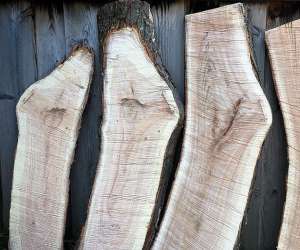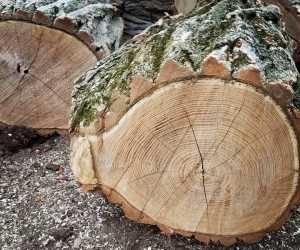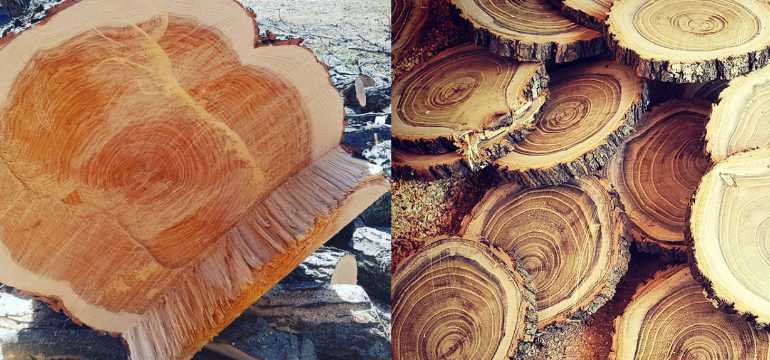As you work on various projects around your home, you will become more and more familiar with the various materials that are available for each application. For example, if working with wood is your thing, you will find that there is a seemingly endless variety of wood types that you can use for structural elements, trim and molding, furniture, cabinetry, and much more. Eventually, you will be comfortable moving beyond the more familiar, less expensive woods like oak, poplar, pine, and fir, and you will probably try experimenting with more costly wood like cherry, maple, mahogany, ash, and elm.
In the course of your forays into various types of wood, you may come across the locust tree and its lumber. In this guide, we will take a look at two common types of locust and compare their differences. Once you compare honey locust vs. black locust, you will be able to determine which type of locust lumber might best suit the project you have in mind.
Honey Locust vs. Black Locust
Hardness
When it comes to deciding between black locust or honey locust, the first thing you probably want to consider is the hardness of each type of lumber. Hardness is measured on the Janka scale and is quantified by pound-feet, represented as lb-ft or lbf.
This number represents how strong, tough, and impact-resistant the wood is. Softer trees tend to be easier to damage, and they may not take stain well due to the looser texture of their wood or their odd coloring. Hardwoods can be more difficult to work with, but they accept stain well and often include beautiful grain patterns, which make them more desirable to woodworkers and homeowners.
On the Janka scale, the honey locust has a hardness of 1580 lbf, which is actually quite high. By contrast, the black locust has an even higher ranking. It comes in at 1700 lbf on the Janka scale. So by this measure, we can see that black locust is harder, tougher, and more durable. So if you are looking to select wood purely based on its level of hardness and durability, you may want to go with the black locust lumber for your project.
Color

Honey locust
There is another key consideration that is generally very important to woodworkers and homeowners, and that is the color of the wood. The color of a tree’s wood typically varies depending on the area from which the lumber is cut. That is, the heartwood, or wood cut from the very center of a big, mature tree, may have a slightly different hue from the outer wood, or wide sapwood.
For the honey locust, the wide sapwood bears a pale yellow hue. Its heartwood is quite a bit darker, with a reddish-brown ranging from lighter to fairly vivid. In appearance, the honey locust has wood with very similar coloring to the Kentucky Coffeetree.

Black locust
Black locust lumber has a slightly different color palette. Its wood tends to be a bit darker, especially at the heart. The heartwood is usually a deep russet brown, while the outer wood is light yellow, sometimes with a greenish tint. Black locust and honey locust lumber are often so similar that buyers confuse them with each other. Black locust lumber is also somewhat similar in appearance to the lumber of the Osage Orange tree.
Grain and Overall Appearance
As far as grain appearance goes, the honey locust tree usually has a fairly straight grain, though it may be naturally wavy or irregular in places. The texture is moderately even, and the wood has a natural luster of its own, which is moderate in comparison to the innate luster of other trees.
Black locust has a similar grain. However, its grain is somewhat straighter than that of the honey locust. Like its sister locust tree, its wood has a medium luster and texture. Overall, both honey locust and black locust are fairly appealing to the eye.
Common Uses
Both types of lumber are suitable for a wide variety of uses. Honey locust wood makes excellent furniture, and it may also be used to create sturdy fence posts. It is useful as utility lumber. Some woodworkers like turning honey locust for various projects.
Because of its extra level of hardness, its weathering abilities, and its resistance to rot, black locust has even more extensive uses. It is often used as fence posts, like honey locust; but it may also be found in mine timbers, railroad ties, and flooring. Sometimes it is crafted into veneer. Other times it is made into beautiful furniture. It’s well-liked for turned objects, and boat builders tend to appreciate its qualities as well.
The Ease of Workability
Since black locust is so hard and durable, it can be a bit more difficult to manipulate and craft, compared to other types of wood. Its straight grain is attractive and can be helpful during the machining process, but since it is so hard, it may cause cutting edges of tools to become blunted on a regular basis, so be prepared to deal with that. Lathe turning or steam bending are both preferred ways to work with this type of wood. It is also responsive to gluing and to finishes of various kinds.
Like its companion, the black locust, honey locust lumber can be a bit tricky to deal with. Its hardness and density make the machining process longer, and you may have to keep sharpening your tools if you are working with a lot of it. However, like black locust, it handles staining, gluing, finishing, and turning very well, and you will likely be pleased with the beautiful result.
Cost
Black locust is often sold at prices comparable to those of white oak. However, it is important to consider how your location and the availability of the wood in your area may affect pricing. If the black locust lumber has to be imported, it will cost a lot more.
Honey locust is often more expensive than black locust because it is rarer and more difficult to find and import. Within the natural range of honey locust trees, you should be able to find some of the wood available. However, keep in mind that the price of honey locust will be in the mid-tier or upper tier of what you can expect to pay for a domestic hardwood. Although honey locust is not considered a threatened species, it is still not widely available, and the cost is higher due to limited quantities. If you do not have a specific reason for choosing honey locust for a project, you may want to simply go with the black locust instead.
Tyloses
One key difference between honey locust vs. black locust is the presence of tyloses. Tylosis is distension of a plant cell. Often these anomalies result from stress or damage to a woody plant. These swollen areas can affect the overall appearance of the wood.
When you are comparing black locust and honey locust, you will find many similarities in the overall color, appearance, and other aspects. However, one differentiating factor is the presence and quantity of tyloses. Many black locust trees have pores that are full of tyloses. By contrast, the honey locust wood has few if any such anomalies. This fact does not generally affect the overall appearance of the finished wood, however.
Overview: Honey Locust vs. Black Locust
When you are choosing between black locust or honey locust, you may find it helpful to look at other types of lumber with which these cousin trees are often compared. Black locust is often in competition with hickory, while honey locust is sometimes compared to the Kentucky Coffeetree.
In fact, despite the similarity in their names, the black locust and honey locust are not technically in the same genus. Black locust belongs in the Robinia genus, and honey locust belongs in the Gleditsia genus. Comparing their differences is somewhat like trying to tell white oak apart from red oak.
There is a similar kind of tree known as the water locust, or Gleditsia aquatica, which shares some aspects with the honey locust and black locust. However, it tends to grow in swamps in the southern regions of the USA.
Ultimately, black locust has some advantages over the honey locust. It’s somewhat harder and bears more resistance to weathering and rot. It is also more widely available and therefore, it is usually cheaper. However, it is also a bit harder to machine and tougher to work with overall. And its wood contains many more tyloses than honey locust. Plus, the colors of the two trees are slightly different.
- How to Cut Lexan - September 25, 2020
- Mineral Spirits vs. Mineral Oil - September 25, 2020
- Shellac vs. Polyurethane - September 24, 2020

